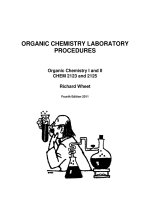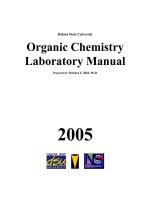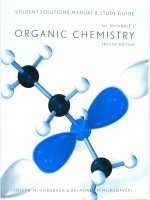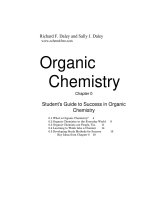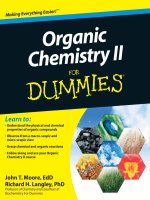organic chemistry
Bạn đang xem bản rút gọn của tài liệu. Xem và tải ngay bản đầy đủ của tài liệu tại đây (682.52 KB, 68 trang )
Organic Chemistry
www.pdfgrip.com
Introductions
1. Organic chemicals compounds appear in materials
like clothing, fuels, polymers dyes and medicines.
2. F. Wohler synthesised an organic compound, urea
from an inorganic compound, ammonium cyanate.
www.pdfgrip.com
STRUCTURAL REPRESENTATION OF
ORGANIC COMPOUNDS
Complete, condensed and bond line
structural formulas
Organic compounds structures are represented
in several ways.
1. The Lewis structure or dot structure, dash structure,
condensed structure and bond line structural
formulas are some of the specific types.
2. The Lewis structures, however, can be simplified
by representing the two-electron covalent
bond by a dash (–).
www.pdfgrip.com
Thus, ethane (C2H6), ethene (C2H4), ethyne (C2H2)
Such structural representations are called
complete structural formula
H
H
H
H
C
C
H
C
H
C
H
H
H
H
Ethene
Ethane
H
C
C
Ethyne
www.pdfgrip.com
H
These structures can also be represented by the following
ways
CH3 CH3 H2C
H2C HC
HC
Ethane
Ethene
Ethyne
organic chemists use another way of representing the
structures, in which only lines are used. In this bond-line
structural representation of organic compounds, carbon and
hydrogen atoms are not shown and the lines representing
carbon-carbon bonds are drawn in a zig-zag fashion.
For example
3-Methyloctane can be represented in various
forms as:
i)
CH3CH2CHCH2CH2CH2CH2CH3
|
CH3
www.pdfgrip.com
www.pdfgrip.com
www.pdfgrip.com
www.pdfgrip.com
Three-Dimensional Representation of
Organic Molecules
The three-dimensional (3-D) structure of organic
molecules can be represented on paper by using certain
conventions. For example, by using solid
and dashed
wedge formula, the 3-D image of a molecule from a twodimensional picture can be perceived.
___________________________________________________________
solid-wedge is used to indicate a bond projecting
out of the plane of paper, towards the observer.
The dashed-wedge is used to depict the bond
projecting out of the plane of the paper and
away from the observer.
www.pdfgrip.com
The bonds lying in plane of the paper are depicted by using a
normal line (—).
Wedge-and-dash representation of CH4
www.pdfgrip.com
CLASSIFICATION OF ORGANIC
COMPOUNDS
www.pdfgrip.com
Acyclic or open chain compounds
These compounds are also called as aliphatic compounds and
consist of straight or branched chain compounds, for example:
www.pdfgrip.com
Alicyclic or closed chain or ring compounds
Alicyclic (aliphatic cyclic) compounds contain carbon atoms
joined in the form of a ring (homocyclic). Sometimes atoms
other than carbon are also present in the ring (heterocylic).
Some examples are
www.pdfgrip.com
Aromatic compounds
Aromatic compounds are special types of compounds.
These include benzene and other related ring
compounds (benzenoid).
www.pdfgrip.com
In order to clearly identify compound, a systematic method
of naming has been developed and is known as the IUPAC
(International Union of Pure and Applied Chemistry)
system of nomenclature.
The names are correlated with the structure such that the
reader or listener can deduce the structure from the name.
www.pdfgrip.com
The traditional names are considered a trivial or common
names.
www.pdfgrip.com
Hydrocarbons : Compounds containing carbon and hydrogen
only are called hydrocarbons.
www.pdfgrip.com
www.pdfgrip.com
Straight chain hydrocarbons: The names of such compounds are
based on their chain structure, and end with suffix ‘-ane’ and
carry a prefix indicating the number of carbon atoms present in
the chain (except from CH4 to C4H10, where the prefixes are
derived from trivial names).
www.pdfgrip.com
Branched chain hydrocarbons: In a branched chain
compound small chains of carbon atoms are attached at one or
more carbon atoms of the parent chain. The small carbon
chains (branches) are called alkyl groups.
In order to name such compounds, the names of alkyl groups
are prefixed to the name of parent alkane. An alkyl group is
derived from a saturated hydrocarbon by removing a
hydrogen atom from carbon. Thus, CH4 becomes -CH3 and is
called methyl group.
www.pdfgrip.com
Nomenclature of branched chain alkanes
1. First of all, the longest carbon chain in the molecule is identified.
Example
www.pdfgrip.com
2 . The numbering is done in such a way that the branched
carbon atoms get the lowest possible numbers.
3. If different alkyl groups are present, they are listed in alphabetical
order. Thus, name for the compound shown above is: 6-ethyl-2methylnonane.
[Note: the numbers are separated from the groups by
hyphens and there is no break between methyl and nonane.]
www.pdfgrip.com
4. If two or more identical substituent groups are present then
the numbers are separated by commas. The names of identical
substituents are not repeated, instead prefixes such as di (for 2),
tri (for 3), tetra (for 4), penta (for 5), hexa (for 6) etc. are used.
www.pdfgrip.com
5. If the two substituents are found in equivalent positions, the
lower number is given to the one coming first in the alphabetical
listing.
6. The branched alkyl groups can be named by following the above
mentioned procedures. carbon atom ofthe branch that attaches
to the root alkane is numbered 1 as exemplified below.
www.pdfgrip.com
While writing the trivial names of substituents’ in alphabetical
order, the prefixes iso- and neo- are considered to be the part
of the fundamental name of alkyl group. The prefixes sec- and
tert- are not considered to be the part of the fundamental
name.
In multi-substituted compounds, the following rules may also
be remembered:
• If there happens to be two chains of equal size, then
that chain is to be selected which contains more number
of side chains.
• After selection of the chain, numbering is to be done
from the end closer to the substituent.
www.pdfgrip.com
